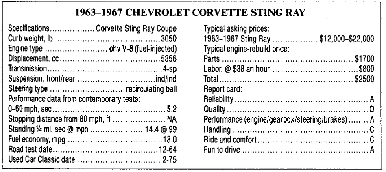 |
330 GT Registry |
 |
1963-1967
Chevrolet Corvette
Sting Ray
While the sporting marques of Europe that we’ve praised in print and coveted in private have introduced fatter, heavier 2 + 2 versions, sometimes with regrettable results, America’s premier sports car has always remained true to the sports- car ideal—two seats. Unlike Aston Mar tins, Ferraris, Jaguars and other voitures de grande luxe et grande tourisme as the French so elegantly say, the Vette has never pretended to be anything more than a good old American 2-passenger sports car.
Of the seven cars we honor in this article, only the Mercedes and the Corvette are worth significantly more today than they cost when new. A good 2 30/250/280 SL goes for two or three times its original price, while a good 1963—1967 Sting Ray is generally worth a whopping four or five times more.
How come? Maybe it’s because Reaganomics, Ra and American jingoism seem to be in vogue at the moment, but I doubt it. More likely, it’s because these Corvettes were incredibly good values to begin with. For about $4000 (Contributing Editor Ron Wakefield bought a new 1964 convertible for $3825) you had a car that would peel the paint off fancy European GTs that cost three times as much. A 1965 Sting Ray with fuel injection and a trusty 327-cu-in. V-8 could do 0—60 mph in 6.3 seconds, according to one of our tests. And with its independent rear suspension, it handled quite well, too. Most European exotica back then were still get ting along on live rear axles.
In addition, the 1963—1967 Corvettes have timeless appeal, unlike their immediate successors. The Sting Ray design was a tour de force, to use another French phrase, when it made its debut in 1963, and still looks terrific more than 20 years later. Over its production run, the design became even better. By 1967, its final year, the n was a clean machine; the fake vents, extraneous emblems and simulated-something-or-other wheel covers of earlier years were gone.
There were some
important mechanical changes during those five years as well. The 1965 model
might be considered the pinnacle year for the Sting Ray. Four- wheel disc brakes
became standard. For the first time, America produced a sports car with all the
right stuff—fuel injection, an independent rear suspension and disc brakes all
around.
For that year only, you could have a carbureted 396-cu-in. V-8 instead, though
it wasn’t nearly as pleasant for everyday use as the 327. “There are many sports
cars that honestly need more power. But the Corvette isn’t one of them,” we said
with a hint of understatement.
Chevrolet paid no heed to us, because in 1966 fuel injection was dropped, the 396 engine was bored out to 427 cu in., and the great horsepower race was in high gear. When GM management was hit with public criticism about excessively big engines, Chevy engineers are said to have given one of the all-time great tongue-in- cheek replies: “More horsepower? Heavens no. Boring out the block achieves a useful weight saving!” Sting Rays with the so-called “big block” option are in demand today, what with mucho-macho musclecars, crewcuts and pegged pants back in style. Which brings up an important point about these Corvettes. They’re American cars, which meant you could have ‘em your way, as the hamburger ad says. While the major option of the typical European sports car of the day was radio or no radio, Chevy offered a scroll of options. You always had a choice of engines, so your Corvette could be a mild-mannered runabout complete with Powerglide (“slip ‘n slide”) automatic transmission, or a stoplight dragster with great gobs of rip-snorting horsepower and torque. You could have it as a convertible with soft top, a convertible with removable hard top or a coupe. You could order electric window lifts and power assisted steering. You had a large selection of interior colors, and even the option of leather upholstery. These Sting Rays were also some of the first sports cars in the world with truly effective heaters and factory air conditioning.
So it’s unlikely that you’ll find two Sting Rays exactly alike. In general, the more options, the more valuable the car. But the vintage Corvette market is very fickle. Big-engine Vettes are “in” now (even though they overheat worse than old Jaguar XK 120s), but a few years ago they weren’t. There was a time when the Sting Ray to have was a 1963 split-window coupe. Now everybody wants a convertible.
Finally, understand that these early Sting Rays with their high-compression engines were designed for a steady diet of very high-octane, heavily leaded gasoline. The stuff is history now, which means you’ll have to either modify the car’s engine or your driving habits.

ROAD & TRACK October 1985
Copyright 1985, CBS, Inc.
